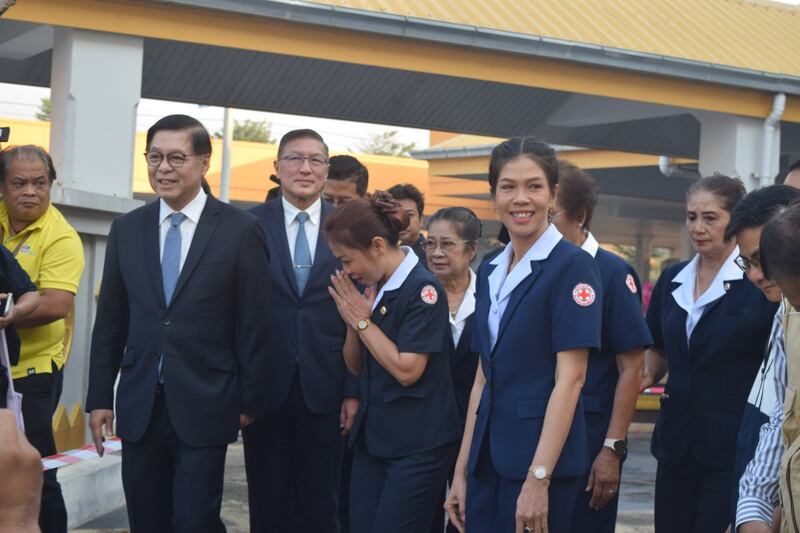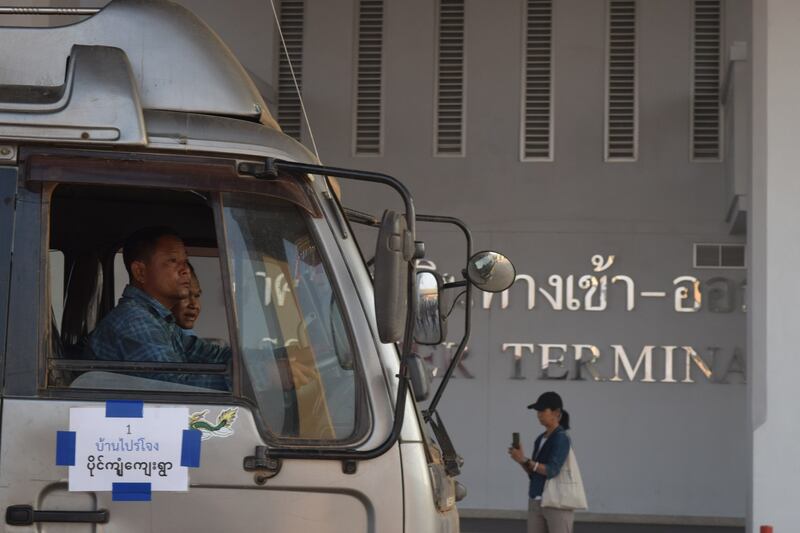Updated March 25, 2024, 09:08 a.m. ET.
Thailand's government started aid deliveries to Myanmar on Monday along a newly developed humanitarian corridor to assist civilians affected by fighting.
The Ministry of Foreign Affairs, in cooperation with the Thai and Myanmar Red Cross Societies, sent aid in an eight-truck convoy across Mae Sot-Myawaddy Friendship Bridge No. 2.
Four thousand packages were delivered to three villages in Kayin state, namely Na Bu in Kawkareik district, and Thar Ma Nya and Paingkyon in Hpa-An district.
The aid will benefit around 20,000 people in towns selected in the pilot project for their acute need, according to Thai Vice Foreign Minister Sihasak Phuangketkeow.
“We hope very much to see peace in Myanmar, internal issues certainly will be resolved by Myanmar themselves,” Sihasak said at the aid ceremony in Mae Sot. “We want every side, all sides, to overcome their differences so that we can be led to reconciliation and peace in the near future.”

Sihasak previously expressed hope that the aid initiative could help open the way for dialogue between the civilian National Unity Government, ethnic armed organizations and the junta, which seized power from the democratically elected government in a February 2021 coup d'état.
However, he declined to comment Monday on which groups controlled the territory to which aid would be delivered.
“I don’t want to look at the issue as to which area is controlled by which side, let’s talk about the people who are affected. If there is an area where there is a need, then we have to take a look.” he said. “We are ready to work with everyone, as long as the focus is the people receiving the humanitarian aid.”
Renewed fighting fuels need
Some non-junta stakeholders have criticized the limited scope of the assistance. However, a resurgence in fighting has increased the number of people in need of aid, whatever the amount.
After the anti-junta Karen National Liberation Army launched an assault on military camps in Myanmar’s Myawaddy township on March 7, civilians were left displaced and in need of both food and medicine, according to a spokesperson for the Karen Department of Health and Welfare, declining to be named for security reasons.
As many as 30 people were critically injured during battles, and at least three have died from serious injuries in southern Myawaddy and Kawkareik townships. Nearly 3,000 new internally displaced people have been identified since March 7, but the number is likely higher, the spokesperson said.
She added that many of them are suffering from diarrhea and fever because they are drinking river water due to the heat.
Skirmishes and humanitarian issues are also increasingly affecting Thailand's border. Large numbers of migrants fleeing conscription laws enacted by the junta fled through Thai borders, the largest number being arrested in Tak province in February.
On Tuesday, 40 junta soldiers fled into Thailand's Umphang district, about 180 kilometers (112 miles) south of Mae Sot, according to the Karen Information Center. The week-long battle with the Karen National Liberation Army caused Thailand to close its border crossing near Paing Ka Hlaing village in Kayin state.
Engaging all parties?
Despite the foreign affairs ministry’s claims to engage all parties, some stakeholders don’t feel an adequate effort has been made.
Aid would be handed off to community leaders and the district authority in recipient villages, Sihasak said.

But the National Unity Government's Ministry of Humanitarian Assistance, along with ethnic armed groups, has drafted an alternative proposal that it said would make Thailand's aid delivery plan more effective. It proposed instead to work with local organizations to reach areas controlled by ethnic armed groups.
However, the National Unity Government – a shadow government formed by members of the civil administration ousted in the coup – says there has been no direct communication from Thailand’s Ministry of Foreign Affairs about the plan, proposed ahead of a seminar in Bangkok earlier this month on the situation in Myanmar.
“For effective delivery of such aid to the most needy people, close cooperation with EROs [ethnic resistance organizations] and NUG [National Unity Government] will be of paramount importance,” said Win Myat Aye, the minister of Humanitarian Assistance and Disaster Management.
“Given Thailand's status as a pivotal neighboring country to Myanmar, coordinated and collaborative efforts with NUG and EROs are imperative to resolve the ongoing crisis through diplomatic channels.”
Thai authorities have reached out to one or two ethnic armed groups, according to a source who asked to remain anonymous due to the sensitivity of the situation. He declined to name them.
The Karen National Union, running parts of Kayin state, declined to comment on whether Thailand had discussed the delivery with them.
Lalita Hanwong, a historian at Kasetsart University and advisor to the Thai government on national security issues, said the humanitarian corridor was a positive development.
“I believe that the security sector and the Thai government have thoroughly considered this matter,” she told BenarNews. “What Thailand should do next is to initiate negotiations with minorities, especially those in areas bordering Thailand, to ensure sustainable assistance.
“Thailand's long-term plan should prepare for various scenarios that could arise with Myanmar, such as fragmentation into multiple groups like the Shan, Karen, and Mon.”
Updated to include comment from a Thai government advisor.
BenarNews reporter Ruj Chuenban contributed to this story from Bangkok.
Edited by Mike Firn and Taejun Kang.
